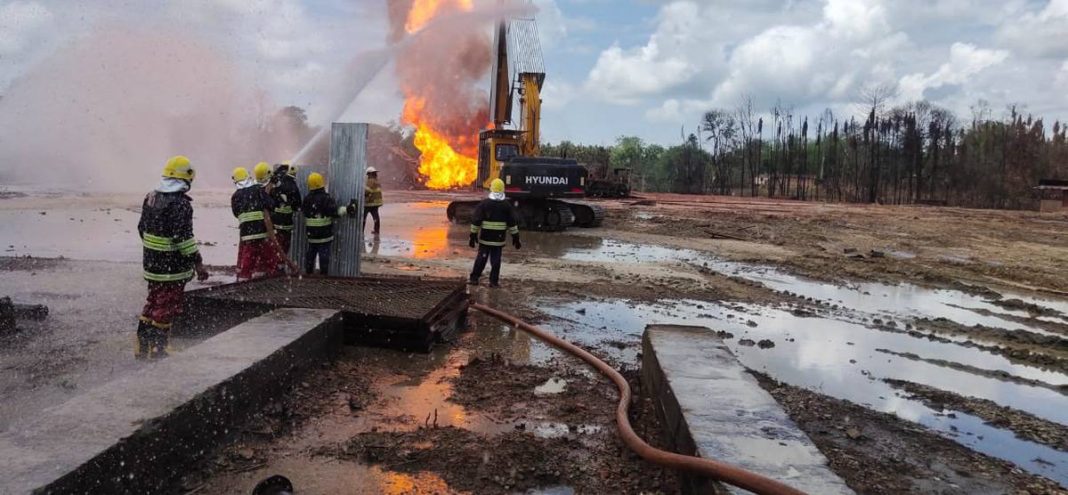An NGT report exposed the fact that the oilfield in Assam is operating without mandatory environmental clearances. It also said that a blowout has been spewing gas for 160 days now, impacting 10 km of eco-sensitive land.
By Sujit Bhar
Picture this. An entire oil and gas field, with its highly polluting oil and gas rigs, has been operating within sniffing distance of Assam’s highly eco-sensitive Dibru Saikhowa National Park. The park, located across the Dibrugarh and Tinsukia districts, was designated a Biosphere Reserve in July 1997. This park encapsulates the largest salix (of the willow genus) swamp forest in north-eastern India and is said to be a haven for many endangered species and is rich in its fish diversity.
There is more to the Baghjan oilfield which belongs to the government’s Oil India Ltd (OIL). It has no environmental clearance, and benefited from the central government’s January 18 order which exempted all oil and gas firms conducting exploratory drilling from legal requirements for environmental clearances. Not that people of the area wanted it. There were public protests after the central government announced that OIL had been authorised to explore the area under Dibru Saikhowa National Park for hydrocarbons. These protests were stamped out.
Then, with an entire oilfield operating without any care for life and livelihood, forget flora and fauna, the inevitable happened. On a quiet morning (10.30 am) of May 27, Well No. 5 blew out. The sound was heard all around Baghjan village as well as in Tinsukia town, 12 km from the oilfield. It did not end with one blowout. According to local reports, natural gas kept gushing out of the uncapped wells and explosions continued. The well which blew (Well No. 5) and kept on leaking is barely 900 m from the biodiversity park, just off its buffer region. The rivers were polluted, plants and animals were affected and a large number of villagers have been displaced.
The case was referred to the National Green Tribunal (NGT) by Bonani Kakkar and the Wildlife and Environment Conservation Organisation. They wanted a full investigation. The NGT agreed and a committee, led by former Gauhati High Court judge Brojendra Prasad Katakey, was set up on June 24, mandated to investigate the reason for the blowout.
When the committee reported its findings on November 3, the Court found it unbelievable. The report said that the Baghjan oilfield, as well as 26 others in Assam, are operating without mandatory environmental clearances. It also said that the after effects of the blowout have not stopped, and it has been spewing gas for 160 days now, impacting 10 km of eco-sensitive land around the oil and gas rig.
Justice Katakey has recommended legal action against Oil India Ltd (OIL) for violating the air, water and environmental protection acts. This also means that legal action will have to be taken against the relevant ministry of the centre. Says the report: “Such actions place OIL in continuing contempt of the directions passed by the Supreme Court of India, specifically the order dated 07.09.2017 granting conditional approval to OIL to undertake the present extraction of hydrocarbons from the proposed wells, including the Baghjan Well-5.”
The committee has also recommended payment of Rs 25 lakh to 173 families and Rs 20 lakh to 439 families identified by the district administration. The final report is likely to be submitted by the Committee by December 15. Earlier, the Central Pollution Control Board had classified oil and gas extraction as red category industries and had prohibited their operations in ecologically fragile areas and protected areas.
So what allowed OIL to act with impunity? Does a government mandate to extract oil and gas come with a carte blanche for the explorer to dig and extract as it wishes, with nary a thought about Mother Earth, about lives and livelihoods, about plants and animals that are supposed to be protected? Well, it does not. Somebody read the script wrong. In environmental terms, the entire idea of an oilfield in that region would reek of callousness. Even incredibly powerful oil lobbies in the US have had a tough task in exploiting natural resources in Alaska. Every fracking effort has been tied to lawsuits. Technically, there is no way that any government fiat can be routed around the Ministry of Environment & Forests the ministry is also the nodal agency in the country for the United Nations Environment Programme (UNEP) and the Central Pollution Control Board (CPCB).
As a result, Assam’s pollution watchdog ordered OIL to shut down production and drilling at all installations in Upper Assam’s Baghjan. The watchdog found out even before the committee had reported to the NGT that the company had started operations without obtaining prior consent to operate from it. That constituted a serious breach of provisions of the Water Act, 1974, Air Act, 1981 as well as Environment Protection Act, 1986.
How this patently illegal act happened and how it was allowed to function without relevant permits and clearances by other government agencies would be the key investigation areas. While this just might be escalated to the Supreme Court for proper muscle, the only silver lining so far has been the acknowledgement of the massive environmental disaster by the Assam government.
This buck needs to roll to the top before stopping. If government agencies blatantly flout government laws, somebody has to pay the price. The disaster has been extensive, and when river waters are polluted, the damage extends to hundreds, if not thousands of miles downstream and to millions of inhabitants who have little idea of the nauseous activities perpetrated upstream.
Instead of finding a scapegoat, the government needs to set up its own fact finding committee to supplement what the NGT is doing, before international pressure bears down upon it. The MoE&F’s credibility has been hit the hardest. The gatekeeper to the nation’s lungs will have to find a good excuse and a better action plan. Legal action is on its way.


